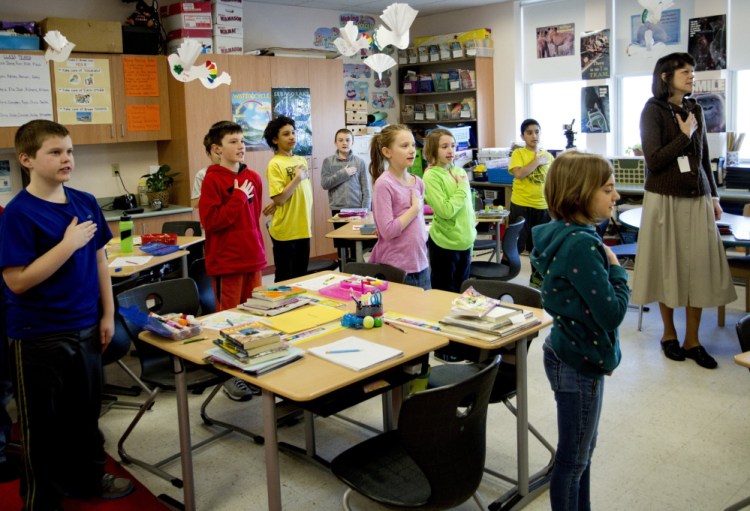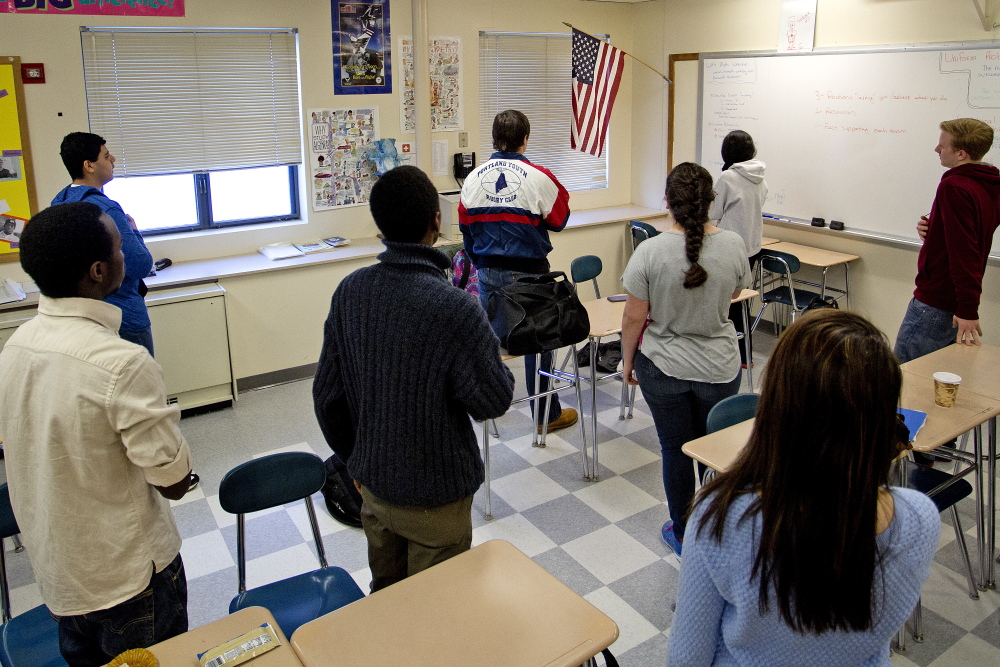When three students at South Portland High School challenged how students are asked each morning to recite the Pledge of Allegiance, touching off strong reaction in their community and far beyond, they perhaps unknowingly revived a controversy practically as old as the pledge itself.
For decades from elementary school onward, students in southern Maine and across the nation have been led in the daily oath of loyalty that is a source of pride for many parents and students. But the simple pledge also is the source of persistent questions about whether it is a coerced ritual, about the ability for schools to institutionalize patriotism, and about a parent’s or student’s right to opt out of such an exercise.
Even in courts, where judges are accustomed to wading through murky social issues, cases involving the pledge trigger emotional responses like only a few other topics.
“This just hits raw nerves of people – (issues of) patriotism and religion and God,” said Jesse Choper, a legal scholar and professor at the University of California Berkeley who has written about the struggle to define, limit and legislate the pledge.
Local tensions were ignited in February when the three South Portland High students, led by the senior class president, changed the introduction of the pledge to make it clearer to fellow students that joining in is optional. Maine law says that pledging is not mandatory, although schools must give each student an opportunity to recite it.
The girls were praised in some corners but also faced an angry backlash, especially online, where some critics said they disrespected the country and the uniformed men and women who serve it.
The furor continued last week, even as the students and staff reached a compromise: Students would be invited to join the pledge and would be periodically instructed about the pledge and their legal right to abstain.
STILL SACROSANCT TO MANY
Elsewhere, other students have run into trouble for tampering with the sacrosanct words. Last month in New York, for example, a student celebrating National Foreign Language Week ignited a torrent of criticism and threats after he recited the pledge in Arabic on the school loudspeaker.
In southern Maine, of 23 public and private elementary, middle and high schools surveyed last week by the Portland Press Herald, nearly all included the pledge in their daily routines.
Westbrook High School Principal Jonathan Ross said he was not aware of a time in Westbrook when the pledge was not recited.
“I really didn’t give it a whole lot of thought until I saw those articles,” Ross said. “I thought, ‘Poor South Portland.’ Around here, the Pledge of Allegiance is just like part of ‘Good morning, Westbrook High School.’ ”
The only public school surveyed that doesn’t recite the pledge daily was Cape Elizabeth High School. Some private schools, including Gould Academy, Waynflete School and the Breakwater School, also do not pledge.
Cape Elizabeth Principal Jeff Shedd said students, teachers and administrators had not been reciting the pledge before Sept. 11, 2001, but began again after the national tragedies at the World Trade Center, the Pentagon, and in Pennsylvania. South Portland High was one of the other Maine schools that resumed the pledge after the terrorist attacks.
“We continued with this practice for a couple of years until students and others suggested to us that it tended to lose its meaningfulness – and occasionally invited controversy – when repeated every day,” Shedd said in an email.
He said the school now uses moments of silence combined with the pledge on patriotic holidays and memorials to honor sacrifices made on behalf of the nation. “I actually think this invites a much higher degree of respect, reflection and appreciation than a daily required recitation,” Shedd said.
Cape High student Hunter Stephenson said he believes that most students are “pretty indifferent” to the pledge.
“I think it’s nice to have the freedom of choice to do it, but it shouldn’t be pushed on anyone,” said Stephenson, 15. Having to be the one to either opt out or opt in would be awkward, he said.
BELLAMY’S LEGACY
Although the pledge may appear to be a seamless part of the American experience, it is a relatively recent invention. The first pledge was written by Francis Bellamy, an editor in the late 19th century for a popular magazine, “Youth’s Companion,” based in Boston.
As part of a national effort by the magazine’s staff to institute school celebrations of Columbus Day in 1892, Bellamy published the first pledge, which is markedly different from the 31 words so fastidiously repeated in classrooms today.
Bellamy’s original version had people pledge to “my flag,” which stood unchanged until 1923. Then, with some Americans fearing that “my flag” would allow newly arrived immigrants to reserve fealty to their countries of origin, the pledge was changed to “the flag of the United States,” and then a year later to “the flag of the United States of America.”
Accompanying the pledge was also the so-called “Bellamy Salute,” in which students raised their right arm and held it straight ahead, with the palm held flat and the thumb pointing up. This gesture, remarkably similar to the “Heil Hitler” salute, was changed in 1942, when Congress instituted the hand-over-heart policy.
‘UNDER GOD’ CAME LATER
Before World War II, the pledge was less frequently used and did not carry the same social currency it does today. After the war, when the threat of communism loomed, congressional lawmakers amended the pledge in 1954 to include the words “under God,” a point of contrast to the godless socialists. The addition of “under God” has been a frequent point of contention since then.
During the 1930s, ’40 and ’50s, states began passing laws mandating that students recite the words, bringing some of the first widespread objections to the pledge itself.
The first case to reach the U.S. Supreme Court came in 1940, when a group of Jehovah’s Witnesses argued that a mandatory salute to the flag was a violation of their religious prohibition of worshiping idols. The court upheld the mandatory pledge law in that case, but reversed itself a few years later. Since then, other cases have added further nuances.
For instance, children cannot be forced to say the pledge, but can be required to stand by as others recite it. Complicating matters is the fact that the courts have found that schools have an inherent interest in promoting civic values and patriotism, said Steven Green, professor of law at Willamette University in Oregon.
JURY STILL OUT
Even to jurists, the Pledge of Allegiance has become something of a “third rail” that always touches off controversy.
“I think most courts just don’t want to go there,” Green said.
If, for instance, a court were to decide that children did not have to stand for the pledge and had to be excused from the room during the daily recitation, they would be subjected to identification and ridicule by their peers for being perceived as un-American or unpatriotic.
“That becomes a Catch-22,” Green said.
The latest legal wrinkle came in 2004, when the U.S. Supreme Court took up the case of a California parent and atheist who objected to his child’s recitation of the pledge, including the “under God” provision. The parent argued that it constituted an establishment of religion, contrary to guarantees in the First Amendment.
A lower court in California had struck “under God” from the pledge as unconstitutional, generating widespread reaction from national politicians. But the Supreme Court reversed the decision on procedural grounds, never deciding the merits of whether having students say “under God” constituted a First Amendment violation.
“This idea of the pledge has become sort of our holy civic religion,” Green said. “Any perceived backtracking of this is often met with a lot of hostility and opposition.”
Staff Writer Noel Gallagher contributed to this report.
Send questions/comments to the editors.





Success. Please wait for the page to reload. If the page does not reload within 5 seconds, please refresh the page.
Enter your email and password to access comments.
Hi, to comment on stories you must . This profile is in addition to your subscription and website login.
Already have a commenting profile? .
Invalid username/password.
Please check your email to confirm and complete your registration.
Only subscribers are eligible to post comments. Please subscribe or login first for digital access. Here’s why.
Use the form below to reset your password. When you've submitted your account email, we will send an email with a reset code.